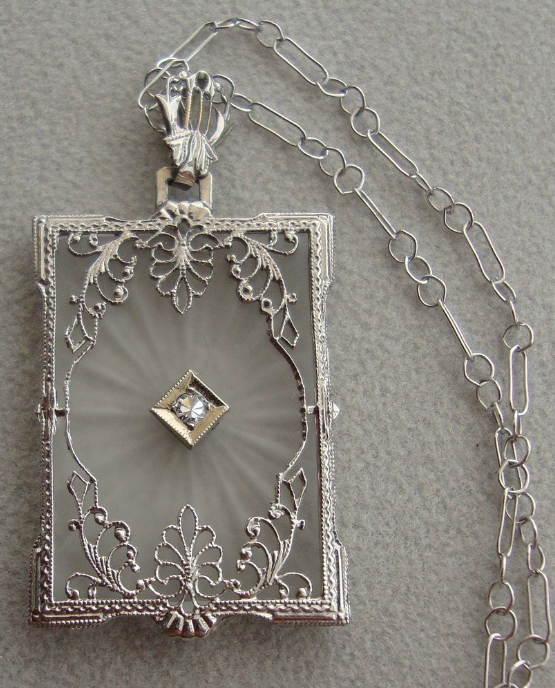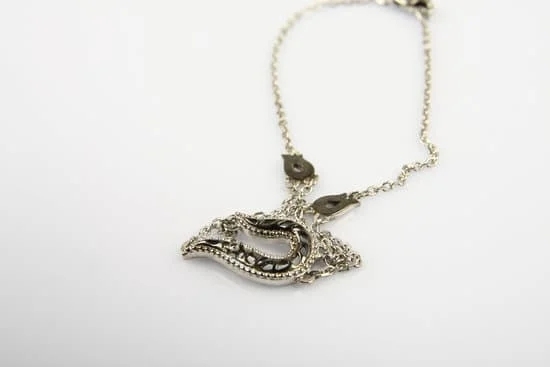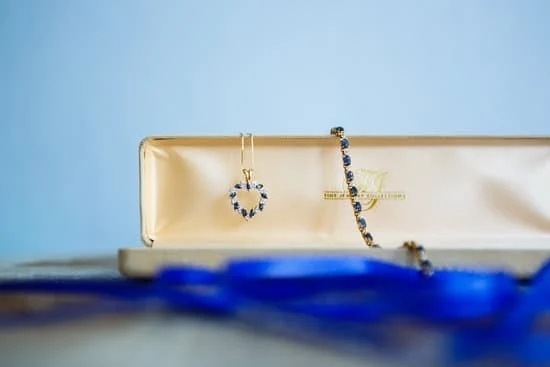Silver and gemstone jewelry can easily lose their shine and luster over time due to exposure to dirt, oils, and other contaminants. Regular cleaning is essential to maintain the beauty and sparkle of these precious pieces. In this article, we will guide you on how to clean silver and gemstone jewelry effectively, ensuring their longevity and keeping them looking their best.
Cleaning your silver and gemstone jewelry not only helps restore their luster but also prevents tarnishing and damage. Over time, silver jewelry can develop a dark patina or tarnish caused by oxidation. Gemstones can become dull or cloudy due to a build-up of dirt and oils. By regularly cleaning these pieces, you can preserve their natural beauty and extend their lifespan.
Understanding the composition of silver and gemstone jewelry is crucial for effective cleaning. Silver jewelry is often made with sterling silver, which contains 92.5% pure silver mixed with other metals like copper or nickel for added durability. Gemstone jewelry includes various types of stones like diamonds, emeralds, rubies, sapphires, pearls, and more. Different cleaning methods may be required depending on the specific characteristics of these materials.
To clean your silver and gemstone jewelry effectively, it is important to have the necessary cleaning solutions and tools on hand. Creating a gentle yet effective cleaning solution using mild dish soap or specialized jewelry cleaners is recommended for most types of jewelry. Additionally, soft brushes or cloths specifically designed for delicate surfaces should be used to avoid scratching or damaging the jewelry during the cleaning process.
In the following sections of this article, we will provide step-by-step guides for cleaning silver jewelry as well as special considerations for cleaning different types of gemstones. We will also share safe storage tips to prevent tarnishing and damage, discuss when it may be necessary to seek professional cleaning services, offer bonus tips for DIY home remedies, and conclude with maintaining the beauty and sparkle of your precious jewelry.
So let’s dive in and learn how to keep your silver and gemstone jewelry looking as good as new.
Understanding the Composition of Silver and Gemstone Jewelry
Silver Jewelry:
Silver jewelry is typically made from sterling silver, which is a mixture of 92.5% silver and 7.5% copper or other alloys. Pure silver is too soft and malleable to be used for jewelry, so the addition of alloys increases its strength and durability. This composition allows silver jewelry to maintain its shape and withstand daily wear and tear.
Gemstone Jewelry:
Gemstone jewelry includes a wide variety of precious and semi-precious stones such as diamonds, rubies, sapphires, emeralds, amethysts, pearls, opals, and many others. These gemstones are usually set in different types of metals like gold or silver to create intricate pieces of jewelry.
To better understand the composition of gemstones, it’s important to note that they can be classified into organic (such as pearls), inorganic (such as diamonds), or mineral-based (such as rubies and sapphires). Each gemstone has unique physical properties that determine its hardness, color, clarity, and other characteristics.
It’s crucial to consider the composition of both silver and gemstone jewelry when cleaning them because different materials require specific cleaning methods to avoid damage or discoloration. In the next sections, we will discuss how to clean each type of jewelry effectively while taking their compositions into account.
| Composition | Silver Jewelry | Gemstone Jewelry |
|---|---|---|
| Primary Material | Sterling Silver (92.5% pure silver mixed with 7.5% copper or other alloys) | Gemstones (diamonds, rubies, sapphires) set in metal (gold or silver) |
| Physical Properties | Soft, malleable, prone to tarnishing | Hardness, color, clarity vary depending on the type of gemstone |
| Cleaning Considerations | Gentle cleaning methods to avoid scratching or damaging the silver | Specific cleaning methods for each type of gemstone to avoid discoloration or damage |
Preparing the Necessary Cleaning Solutions and Tools
Before you begin cleaning your silver and gemstone jewelry, it is essential to gather all the necessary cleaning solutions and tools. Properly preparing for the cleaning process will ensure that you have everything you need to effectively clean and care for your precious jewelry.
One of the most important tools for cleaning silver and gemstone jewelry is a soft-bristled toothbrush. This gentle brush will help remove dirt and grime from intricate designs and settings without scratching or damaging the metal or gemstones. Make sure to keep a separate toothbrush designated solely for jewelry cleaning.
In addition to a soft-bristled toothbrush, you will need a few other common household items to create effective cleaning solutions. For silver jewelry, a simple mixture of warm water and mild dish soap can work wonders in removing tarnish. You can also find commercial silver cleaners available in stores, but make sure to carefully follow the instructions as some cleaners may not be suitable for certain gemstones.
When it comes to gemstone jewelry, different stones require different care. To prepare a suitable solution, start by mixing lukewarm water with a small amount of gentle dish soap.
However, it is crucial to note that some gemstones are sensitive to water and should not be submerged in liquid during the cleaning process. As we explore special considerations for cleaning different types of gemstones later in this article, we will discuss how to prep specific solutions tailored for each type of stone.
By ensuring that you have all the necessary tools and solutions readily available before starting the cleaning process, you can help streamline your efforts and protect your precious jewelry from unnecessary damage. A well-prepared cleaning session will allow you to give proper attention to every detail of your silver and gemstone pieces while ensuring they are well-maintained for years to come.
Step-by-Step Guide
Cleaning silver jewelry is essential to maintain its beauty and prevent tarnishing. Here is a step-by-step guide to help you clean your silver jewelry effectively:
- Gather the necessary materials: You will need mild dish soap, warm water, a soft-bristle toothbrush or a soft cloth, and a microfiber cloth for drying.
- Create a cleaning solution: Fill a small bowl with warm water and add a few drops of mild dish soap. Mix it gently until it forms suds.
- Dip the jewelry: Place your silver jewelry in the soapy water and let it soak for about 5-10 minutes. This will help loosen any dirt or debris stuck on the surface.
- Clean with a toothbrush or cloth: Gently scrub the jewelry using a soft-bristle toothbrush or a soft cloth, focusing on crevices and hard-to-reach areas. Be careful not to apply too much pressure, as this could scratch the silver.
- Rinse thoroughly: Rinse the jewelry under warm running water to remove any soap residue. Ensure that all traces of soap are washed away.
- Dry and polish: Use a microfiber cloth to gently dry your silver jewelry after rinsing. To restore its shine, you can use a silver polishing cloth specifically designed for this purpose.
- Store properly: Once your silver jewelry is clean and dry, store it in an airtight container or zip-lock bag to prevent tarnishing caused by exposure to air and moisture.
Remember that different types of gemstones may require special care when cleaning them alongside your silver jewelry. It’s important to be aware of these considerations to avoid damaging your precious gemstones while cleaning them together with your silver pieces.
Special Considerations
Gemstone jewelry is a popular choice among jewelry enthusiasts due to its vibrant colors and unique properties. However, when it comes to cleaning gemstone jewelry, it is important to understand that different types of gemstones require special care. Cleaning methods that work for one type of gemstone may not be suitable for another. In this section, we will explore the special considerations to keep in mind when cleaning different types of gemstones.
One important factor to consider is the hardness of the gemstone. Gemstones are classified on the Mohs scale of mineral hardness, which ranges from 1 (softest) to 10 (hardest). Softer gemstones such as pearls, opals, and turquoise require gentle cleaning techniques to prevent scratches or damage. On the other hand, harder gemstones like diamonds and sapphires can withstand more rigorous cleaning methods.
In addition to hardness, it is also crucial to consider the porosity of the gemstone. Porous gemstones such as emeralds and pearls can absorb liquids and chemicals, leading to discoloration or even disintegration. These types of gemstones should be cleaned using mild solutions or with a soft cloth dampened with water.
| Gemstone | Cleaning Method |
|---|---|
| Ruby | Use warm soapy water or a commercial jewelry cleaner specifically formulated for rubies. |
| Emerald | Avoid harsh chemicals; clean with mild soap and water using a soft brush. |
| Pearl | Wipe gently with a soft, damp cloth and avoid submerging in water or exposing it to chemicals. |
| Sapphire | Clean with warm soapy water and a soft brush; avoid steam cleaners or ultrasonic cleaning devices. |
Remember, these are just general guidelines and it is always best to consult with a professional jeweler or refer to the care instructions provided with your specific gemstone jewelry. Taking proper care of your gemstone jewelry will help preserve its beauty and ensure that it lasts for years to come.
Safe Storage Tips to Prevent Tarnishing and Damage
Choosing the Right Storage Method
When it comes to storing your silver and gemstone jewelry, it is important to choose the right storage method to prevent tarnishing and damage. One of the best ways to store these precious items is by using individual jewelry pouches or boxes. These provide protection from moisture, dust, and scratches. The pouches should be made of a soft material such as velvet or silk, as harsh materials like plastic can cause scratching.
For added protection, you can place anti-tarnish strips or silica gel packets inside the pouches or boxes where you store your jewelry. Anti-tarnish strips absorb moisture and sulfur-containing gases that cause tarnishing, while silica gel packets help to absorb excess moisture that may be present in the storage area.
Separating and Organizing
To prevent damage and tangling, it is essential to separate and organize your silver and gemstone jewelry properly. This can be done by placing each piece in its own individual compartment within a jewelry box or using dividers within a drawer organizer. This not only prevents tangling but also minimizes contact between different pieces of jewelry that may scratch each other.
It is also important to store delicate gemstone jewelry separately from harder gemstones as they can scratch each other. For example, diamonds are one of the hardest gemstones and can easily scratch softer gemstones like pearls or opals. Therefore, keeping them separated will prolong their lifespan and ensure their original condition is maintained.
Location of Storage
The location where you store your silver and gemstone jewelry also plays a vital role in preventing tarnishing and damage. It is recommended to store them in a cool, dry place away from sunlight and extreme temperatures. Direct sunlight can cause fading of colored gemstones while fluctuations in temperature can lead to expansion or contraction of metals, resulting in damage.
Additionally, you should avoid storing your jewelry in the bathroom or kitchen, as these areas tend to have high humidity levels that can accelerate tarnishing. If possible, store your jewelry in a fabric-lined drawer or a jewelry box specifically designed for storage to provide additional protection from moisture and other elements.
By implementing these safe storage tips, you can ensure that your silver and gemstone jewelry remains in pristine condition for years to come. Proper storage not only prevents tarnishing and damage but also makes it easier to access and enjoy your precious pieces whenever you desire.
When to Seek Professional Cleaning and Maintenance
When it comes to caring for your silver and gemstone jewelry, there are some instances where seeking professional cleaning and maintenance is the best course of action. While regular at-home cleaning can help to maintain the shine and sparkle of your jewelry, there are times when professional help is necessary or recommended.
Difficult Stains or Tarnish
If you have attempted to clean your silver jewelry at home but still notice stubborn stains or tarnish that won’t come off, it may be time to seek professional cleaning. Professionals have access to stronger cleaning solutions and equipment that can effectively remove tough stains without damaging the jewelry. They also have the expertise to determine the best method for cleaning each individual piece, ensuring that it receives proper care.
Fragile Gemstones
Some gemstones are more delicate than others and require special care during the cleaning process. If you have gemstone jewelry with fragile stones such as pearls, opals, or emeralds, it is often safer to entrust their care to a professional jeweler. These experts have experience in handling delicate gemstones and can clean them using gentle techniques that will not cause any damage.
Complicated Settings
Jewelry with intricate or complicated settings can be challenging to clean properly at home. Pieces with multiple stones or settings with hard-to-reach areas can easily trap dirt and grime, making them difficult to clean thoroughly without professional tools. If you have a piece of jewelry with a complex setting that needs cleaning, it is wise to consult a professional who has the necessary tools and skillset for tackling these intricate designs.
Remember, prevention is always better than treatment when it comes to preserving the beauty of your precious jewelry. Regularly having your jewelry professionally cleaned and inspected by a jeweler can help identify potential issues such as loose stones or weakened prongs before they become major problems. By being proactive and seeking professional cleaning and maintenance when necessary, you can ensure that your silver and gemstone jewelry remains in excellent condition for years to come.
Bonus Tips
Many people enjoy cleaning their jewelry at home using simple, everyday ingredients. If you’re looking for a cost-effective and natural way to clean your silver and gemstone jewelry, here are some DIY home remedies that you can try.
For cleaning silver jewelry, one popular method is to use baking soda and aluminum foil. First, line a bowl or sink with aluminum foil. Then, fill it with warm water and add a tablespoon of baking soda. Stir the mixture until the baking soda dissolves.
Next, place your silver jewelry into the solution, making sure they are fully submerged. Leave them in for about 10 minutes before removing and rinsing them thoroughly with clean water. The tarnish should be significantly reduced or even completely removed after this process.
Another effective home remedy for cleaning silver jewelry is using toothpaste. Simply squeeze a small amount of non-gel toothpaste onto a soft cloth or toothbrush and gently rub it onto the silver surface in circular motions. Rinse off the toothpaste with warm water and buff dry with a clean cloth. This method not only helps remove tarnish but also adds shine to your silver jewelry.
When it comes to cleaning gemstone jewelry, one popular DIY method is to use mild dish soap and warm water. Fill a bowl with warm water and add a few drops of mild dish soap. Place your gemstone jewelry into the soapy water and let them soak for a few minutes.
After that, use a soft toothbrush or cloth to gently scrub away any dirt or residue on the gemstones’ surface. Rinse them thoroughly under running water to remove any soapy residue before drying them off with a soft cloth.
Please note that while these DIY home remedies can be effective in cleaning your silver and gemstone jewelry, they may not work for all types of metals and gemstones. Some delicate or porous gemstones may require special care or professional cleaning instead. It’s always important to do your research and understand the specific cleaning requirements for each piece of jewelry to avoid causing any damage.
Conclusion
In conclusion, keeping your silver and gemstone jewelry clean is crucial to maintain their beauty and sparkle. By understanding the composition of these pieces, you can select the appropriate cleaning solutions and tools for effective maintenance. Following a step-by-step guide for cleaning silver jewelry will keep them looking as good as new. Additionally, it’s important to consider special considerations when cleaning different types of gemstones to avoid any damage.
Safe storage practices are also essential in preventing tarnishing and damage to your precious jewelry. Properly storing them in jewelry boxes or soft pouches will help protect them from exposure to air, moisture, and other elements that can cause discoloration or dullness. Furthermore, knowing when to seek professional cleaning and maintenance is necessary for items with delicate designs or embedded gemstones that require specialized care.
Lastly, there are bonus tips for those who prefer DIY home remedies for cleaning silver and gemstone jewelry. However, it’s important to exercise caution with these methods, as some ingredients can be too harsh for certain types of jewelry. Consulting with professionals or conducting thorough research before attempting any DIY methods is recommended.
By following these guidelines for cleaning and maintaining your silver and gemstone jewelry, you can ensure they continue to shine brightly for years to come. Preserve the beauty and sparkle of your precious accessories by taking proper care of them, so you can enjoy their elegance and brilliance whenever you wear them.
Frequently Asked Questions
Is silver cleaner safe for gemstones?
Using silver cleaner on gemstones can be risky, as it may potentially harm or damage the stones. Silver cleaners are designed specifically for removing tarnish and restoring the shine of silver, but they often contain chemicals that can be abrasive or reactive to certain types of gemstones.
Many gems are delicate and susceptible to scratching or discoloration when exposed to harsh cleaning agents. It is best to consult a professional jeweler or refer to the manufacturer’s guidelines before attempting to clean gemstone jewelry with silver cleaner.
What is the best homemade jewelry cleaner for silver?
When considering homemade jewelry cleaners for silver, one popular option is a mixture of warm water and mild dish soap. This gentle solution can effectively remove dirt, oils, and grime from silver without causing any damage. To clean your silver jewelry at home, you can fill a bowl with warm water and add a small amount of dish soap.
Allow the jewelry to soak in this solution for a few minutes before using a soft toothbrush or cloth to gently scrub away any remaining debris. Remember to rinse thoroughly and dry completely before storing or wearing your silver pieces.
How do you clean silver with jewels?
Cleaning silver jewelry that contains gemstones requires extra caution and care compared to cleaning plain silver pieces. It is important to choose a cleaning method that is safe for both the metal and the gemstones. A common approach involves creating a mild cleaning solution by mixing equal parts water and ammonia-free glass cleaner in a bowl.
Gently soak your silver jewelry with gemstones in this solution for around 15-30 minutes, ensuring that all surfaces are covered by the liquid. Afterward, use a soft toothbrush or cloth to gently remove any remaining dirt or debris from both the metal and gemstones. Rinse well under cool running water, pat dry, and allow it to air dry completely before storing or wearing the cleaned jewelry again.

Welcome to my jewelry blog! My name is Sarah and I am the owner of this blog.
I love making jewelry and sharing my creations with others.
So whether you’re someone who loves wearing jewelry yourself or simply enjoys learning about it, be sure to check out my blog for insightful posts on everything related to this exciting topic!





